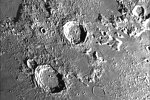 Thierry Legault's
CCD image of Aristoteles (bottom left) and Eudoxus (center).
Thierry Legault's
CCD image of Aristoteles (bottom left) and Eudoxus (center).
See also Morio Higashida's image of Aristotles.
When the interior is only half lit, the central peaklets and interior ruts are highly visible and extremely interesting.
Just north of Aristotles, a combination of rises and craters -- notably A & B -- formed an almost perfect "S" shape. The Lunar Snake! Glances at maps are inconclusive as to whether they are hills or domes; their location makes either fairly likely: they could be ejecta blobs, domes formed from the stresses of impact... beats me. Striking "asterism," though.
| Moon-Lite Atlas for chart 05 |